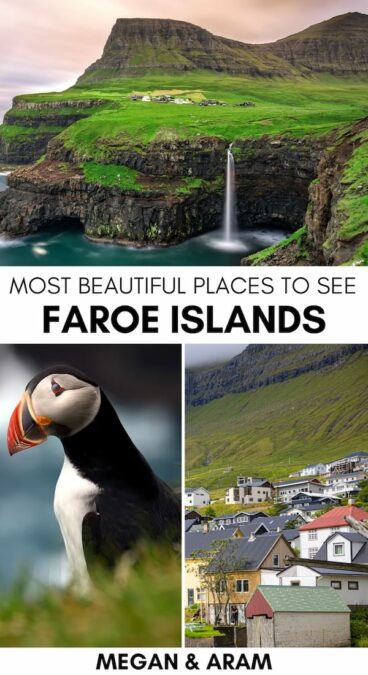Are you looking for the best places to visit in the Faroe Islands? This guide lists some of the top Faroe Islands destinations to add to your itinerary!
Below are some of the top tours, hotels, and transportation options in the Faroe Islands to help you plan your trip!
🚗 Getting around the Faroe Islands (+ airport transfer!):
- Cheapest car rental options (you must book ahead!)
- Vagar airport to Torshavn (a hassle-free transfer service)
🇫🇴 Top Experiences and Tours in the Faroes:
- Outstanding Faroe Islands ʻSee it Allʻ tour (7-hour bestseller!)
- 1.5-hour Vestmanna sea cliffs boat trip (easy half-day option)
- Mykines 7-hour tour (ferry to Mykines – summer option!)
- Kalsoy and Kallur Lighthouse 8-hour guided tour (my fave place!)
🛌 Top Lodging and Hotels in the Faroes:
- Hotel Hafnia (Torshavn)
- Hotel Føroyar (Torshavn)
- Panorama Boathouse (Klaksvik – perfect for visiting Kalsoy)
I honestly don’t believe there is a place that is not photogenic in the Faroe Islands. So, every place in this guide is mind-blowing and worth visiting.
At the end of this post, I have created a map so you can see where all of these gorgeous places in the Faroe Islands are!
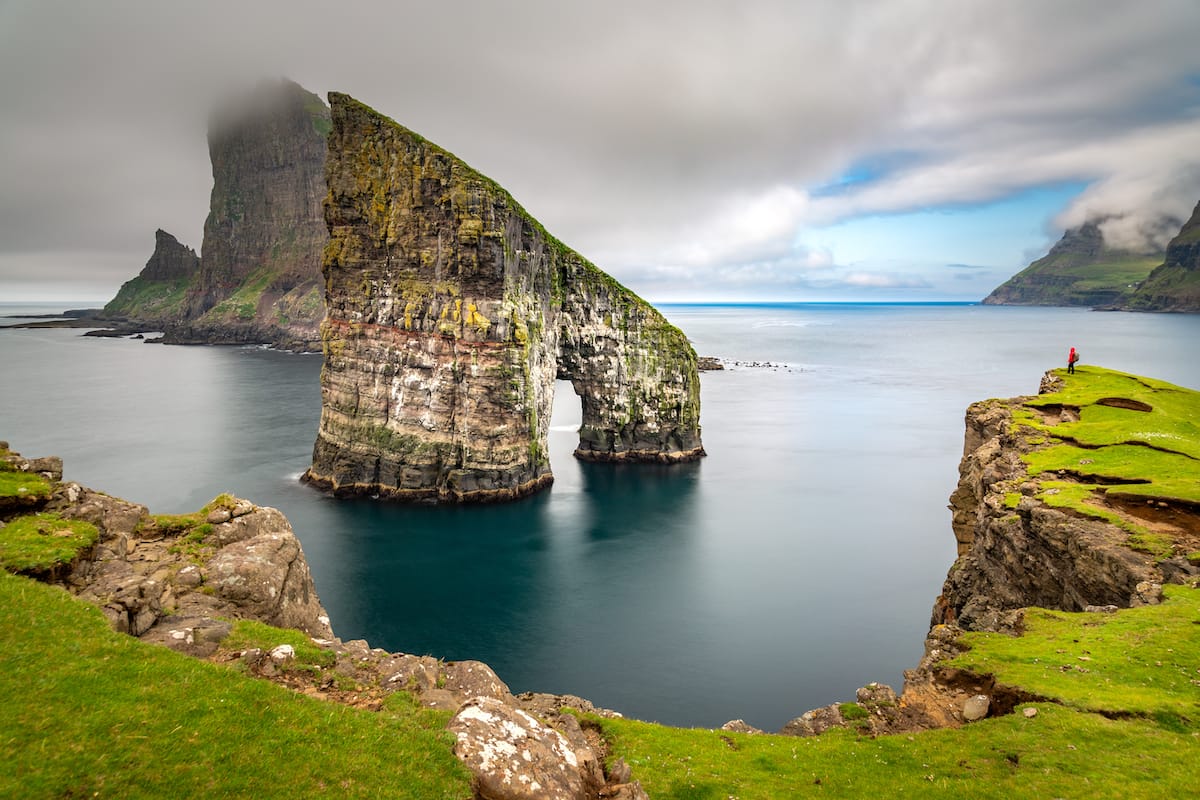
Let me know if you have any questions!
In this post...
Best Places to Visit in the Faroe Islands
1. Kirkjubøur
Kirkjubøur is probably the most significant historical site in the Faroe Islands.
Located on the southern tip of the island of Streymoy, a 15-minute drive from Tórshavn, Kirkjubøur is where history, culture, and stunning scenery come together to create an unforgettable experience.
Start exploring the village with 12th-century St. Olav’s Church, a white building looking so dramatic in all these deep green shades.
The most impressive scenery is waiting for you at the next location, the ruins of St. Magnus Cathedral overlooking the sea. While in ruins, the cathedral is still the largest medieval building in the Faroe Islands.
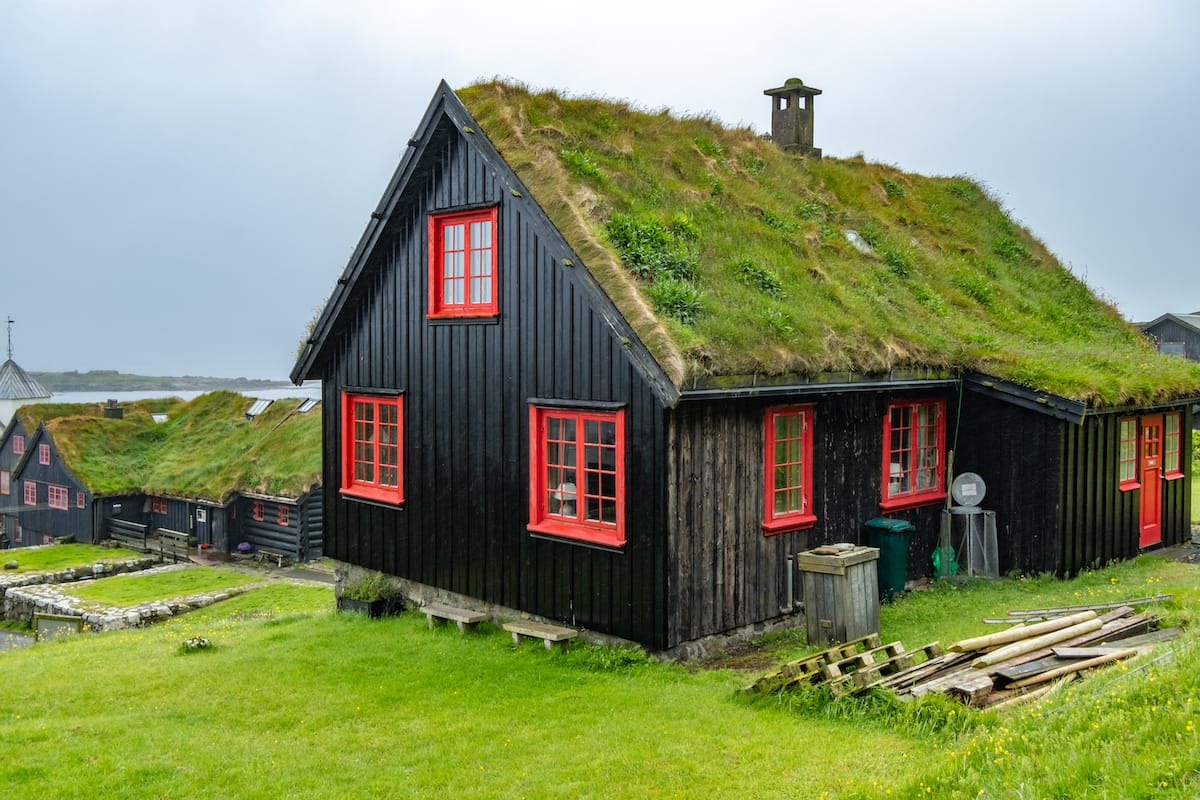
Today it is often visited for a runestone found in 1982, a Viking-age Kirkjubøur stone found near the cathedral.
Kirkjubøur is also home to Roykstovan, or Kirkjubøargarður, one of the oldest inhabited wooden houses in the world. In the 11th century, this historic building was used as the episcopal residence.
You may think nothing is special about a wooden house, but it’s impressive that people on an island with no trees managed to build one. Roykstovan, or smoke room, is the oldest part of the house with a fireplace.
Today, you can have lunch or coffee in Kirkjubøargarður. You can read more about my time in Kirkjubøur here.
2. Nolsoy
The picturesque island of Nólsoy, located just a short ferry ride from Tórshavn, offers a unique blend of natural beauty and traditional Faroese culture.
To reach Nolsoy, you can take a 20-minute ferry ride from Tórshavn; it is a delightful mini-cruise with stunning views of the surrounding landscapes.
There is only one small village on the island and wild nature. And even with its small size, it has a cafe and a bar. Not far from the village, you may see puffins in their natural habitat from May to August.
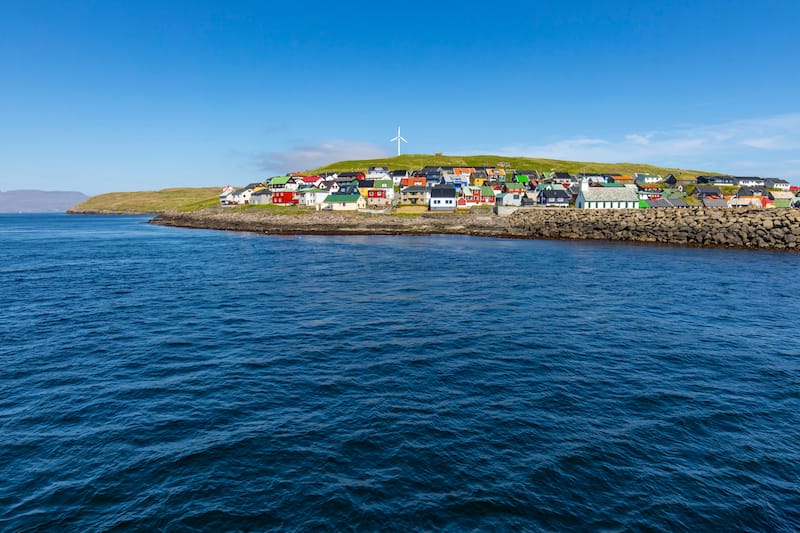
One of the main attractions on Nolsoy is the network of hiking trails that crisscross the island. The hike to the iconic lighthouse, which offers panoramic views of the North Atlantic Ocean, is the most spectacular, with scenes of green valleys and majestic cliffs.
The lighthouse has a lens that was once the world’s largest of its kind.
P.S. Keep in mind that it can get very windy and the weather may change, so be prepared with warm clothes and sturdy shoes.
3. Kallur Lighthouse
Surrounded by the rugged beauty of the Faroe Islands, you will find Kallur Lighthouse, an utterly captivating spot on Kalsoy Island.
With only 150 people living on the island and four small settlements, Kalsoy Island is almost wild, with jaw-dropping views and colonies of Atlantic puffins.
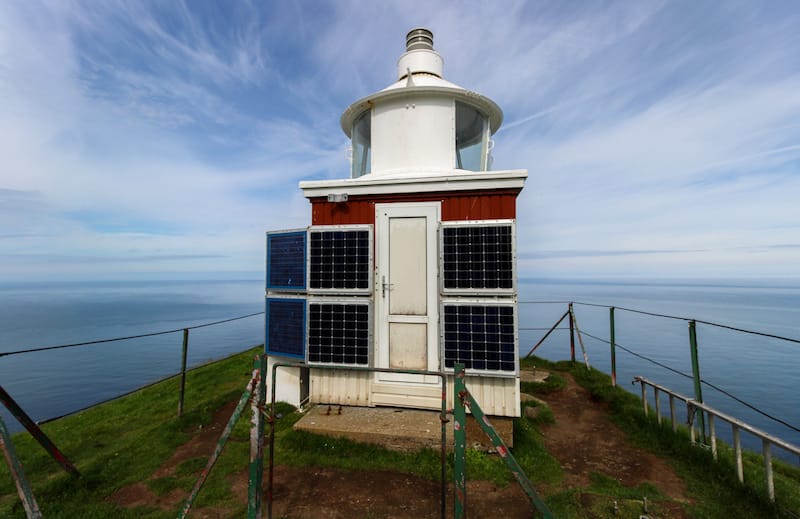
To reach Kallur Lighthouse, you’ll take a 3.9-kilometer (2.4 miles) loop trail through green hills and cliffs near Trøllanes. The route can be a bit challenging, so sturdy hiking boots and appropriate clothing are essential.
As you ascend the trail, you’ll be rewarded with views of the surrounding cliffs, fjords, and the wild North Atlantic Ocean. You can stop here or continue along the narrow spine to get a better view of the lighthouse.
When it gets foggy, stay where you are before it clears. You can read more about my time hiking to the Kallur Lighthouse here.
4. Torshavn
Tórshavn is the heart and soul of the Faroe Islands, its capital, and the largest town named after the god of thunder, Thor.
The capital is located on the largest Streymoy island, where modern architecture blends with traditional emerald-turfed houses.
Start your exploration with the iconic Tinganes Peninsula. This historic district is where the Faroese government has its seat. Tinganes is considered one of the world’s oldest (if not the oldest) parliamentary meeting places.
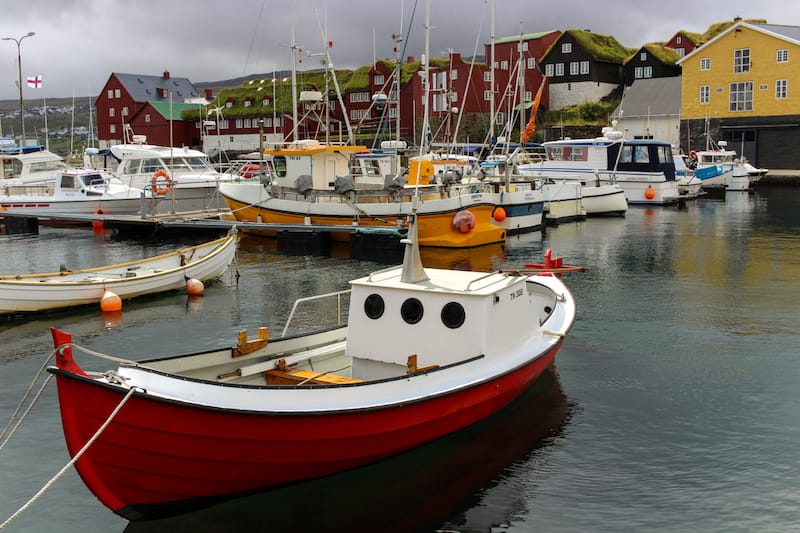
You are free to visit and explore those colorful houses that date back to the Viking Age and even meet the Prime Minister.
After exploring Tinganes, spend some time in the Reyni district, with its black and turf-roofed houses. From the city center, walk to Skansin to discover its lighthouse on top of the old fort.
5. Tjørnuvik
Every corner of the Faroe Islands is a true gem, and exploring them turns into an adventure. One such adventure awaits you on Streymoy Island, the largest of the Faroe Islands.
Despite its somewhat remote location, reaching this coastal paradise is surprisingly easy. Once you reach the island, make your way to the northernmost village of Tjørnuvík, with only 55 houses.
You can come here for beach views from the village with black volcanic sand that looks even more dramatic on a rainy day.

One of the standout features of Tjornuvik Beach is its view of the Risin and Kellingin (the Giant and the Witch) sea stacks. These iconic basalt formations rise dramatically from the ocean.
According to local legends, the Risin stack represents a giant trying to steal the Faroe Islands, while Kellingin represents his wife. You can find more about my trip to Tjørnuvik here.
6. Trøllanes
One of the most visited islands in the Faroe Islands is Kalsoy, with its Trøllanes village and famous Kallur lighthouse (talked about above!). But you hardly know there are other things no less spectacular in Trøllanes not to miss.
The first experience in Trøllanes is the tunnel adventure. Once on Kalsoy, you’ll navigate through a series of 3.5-meter-wide tunnels (about 11 ft) and winding roads, each turn revealing new and mesmerizing views. The drive alone is an adventure.
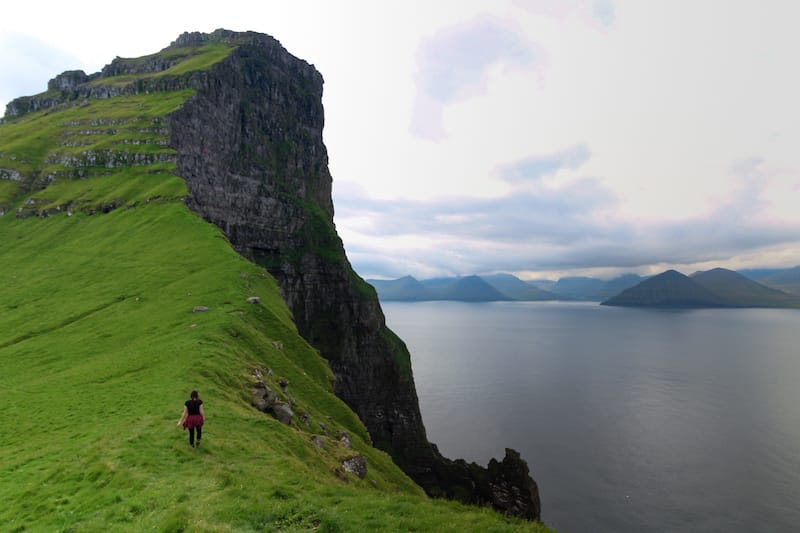
When you arrive in Trøllanes, you’ll find yourself in a quaint village perched on the edge of the Atlantic. By the way, Trøllanes was one of the locations in James Bond’s “No Time to Die” movie.
The iconic Kallur Lighthouse and a scenic hike from the village is the top thing to do on the island.
This moderate hike will take you to a rustic red and white lighthouse that looks almost surreal, surrounded by deep green land.
7. Gasadalur
The Faroe Islands, the land of surreal landscapes, offer another mind-blowing scenery in a village called Gasadalur.
Located on the west side of Vagar Island, this small village was once the most isolated, and therefore, it boasts wild scenery, including the Múlafossur waterfall with its unreal beauty.
Gasadalur is a tiny village with a big personality. With only a handful of houses and a population of around 18 residents, Gasadalur could once be reached only through a strenuous hike.
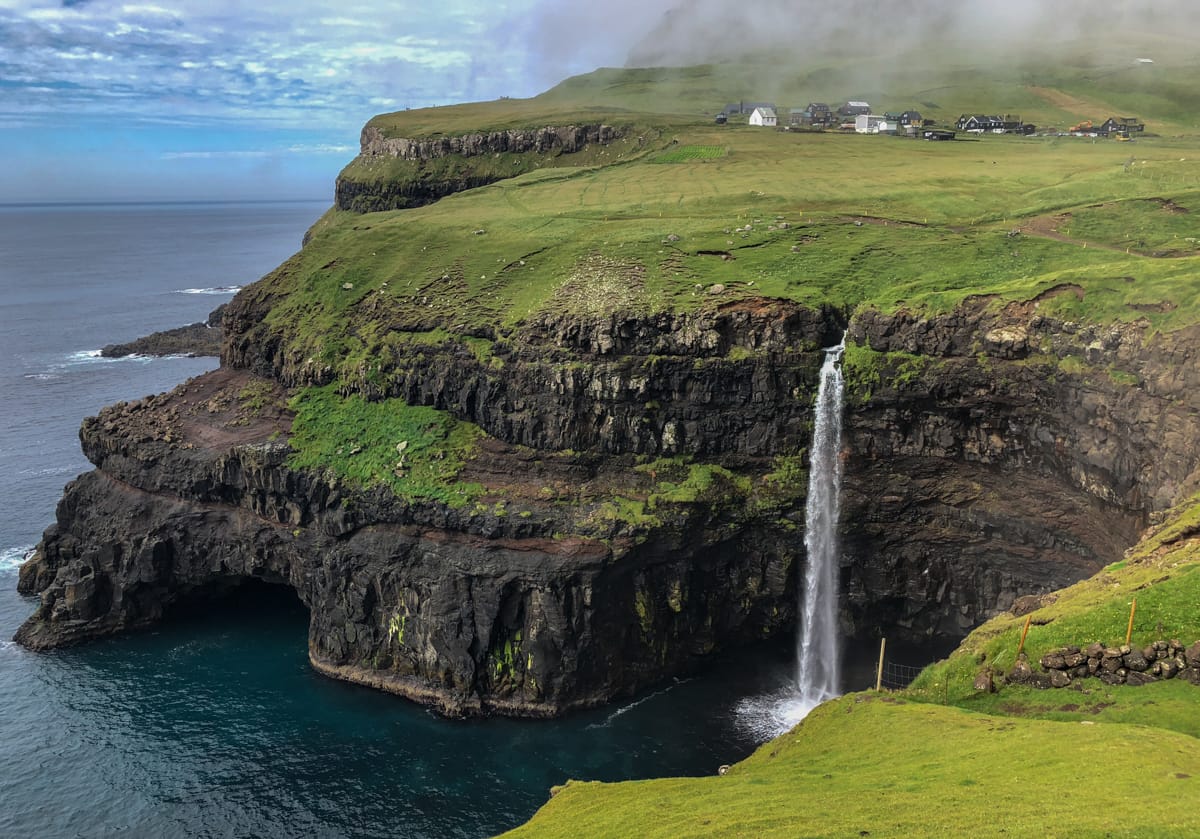
Today, a single tunnel road connects the village to the rest of the world.
Perhaps the most famous attraction in Gasadalur is the majestic Mulafossur waterfall. The viewpoint, located a short hike from the village, 300 meters (980 feet) from the main road, provides an ideal view of Mulafossur.
From this viewpoint, you can continue hiking along the old village path, crossing Gasadals Brekkan hill and its steep slopes. On your way, you may see adorable puffins, inhabitants of the island.
8. Gjogv
Nestled on the northeastern tip of Eysturoy Island, the village of Gjógv is yet another gem of the Faroe Islands, with its dramatic landscapes, cozy cottages, and deep gorge.
Gjógv, pronounced “Gyogv,” takes its name from a 200-meter-long gorge (656 feet) which stretches into the ocean. The village’s valley was used as a harbor for landing the boats, and even today, there are stairs leading down to the gorge.
The only working railway in the Faroe Islands can be found in Gjógv Gorge, which was used to lift cargo from the harbor to the village.
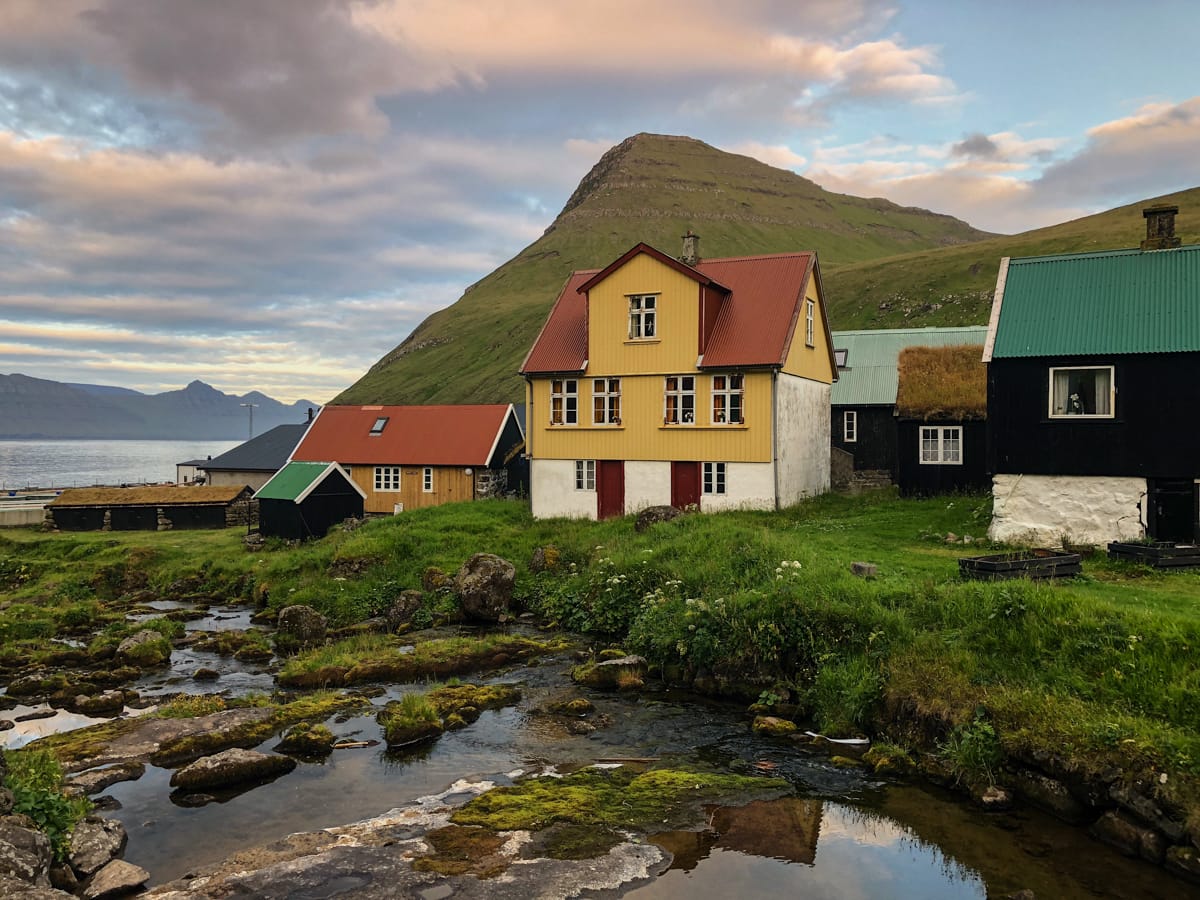
Despite its proximity to the capital, the village is intact, and the lives of 49 villagers have hardly changed for centuries.
If you visit Gjógv from November to March, you will see the gorge filled with white foam contrasting with the black basalt. During the summer months, you will have another, no less exciting attraction, puffins in the gorge.
The main attraction is the views of the gorge and the severe ocean, which took the lives of many of the fishermen. By the way, there is a memorial to those lost in the sea and a church nearby.
You can read more about my trip to Gjogv here.
9. Klakkur
Klakkur, which means “rock,” is a mountain that stands on the island of Eysturoy with an experience that’s both accessible and awe-inspiring.
One of the best ways to experience Klakkur is by hiking to its summit. The hike to the summit is easy and suitable for hikers of all levels. From the top, you will have a full view of Klaksvík and the islands of Kalsoy and Kunoy.
There are two routes leading to Klakkur’s summit. You can choose to start in the town of Klaksvík, the second largest town in the Faroe Islands. It’s a great place to enjoy a meal or immerse yourself in the local culture.
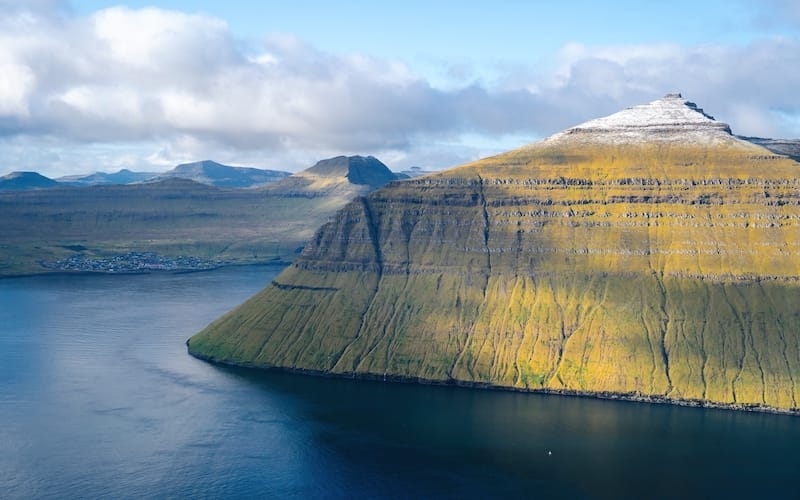
The starting point from Klaksvík is the church that leads to the road winding up to the mountain. You can also drive the road if you feel the steep climb is too much.
The second route starts from Halsur along the Love Path (Astarbravt), a gravel road up to the mountain. Both trails are not marked but worn out, and you can easily follow them.
Once you reach the top, don’t be surprised to find the views wrapped in fog. Wait for a while to enjoy the 360 view.
10. Fossa Waterfall
There is no shortage of breathtaking views in the Faroe Islands, and Fossá waterfall is one more fantastic site you can stand and watch for hours.
The waterfall, located on Streymoy Island, near the village of Haldarsvík, is the tallest on the Faroe Islands.
Standing at an impressive height of 140 meters (459 feet), the waterfall cascades down the basalt cliffs, divided into two levels. The waterfall looks at its most impressive and powerful after a heavy rain.
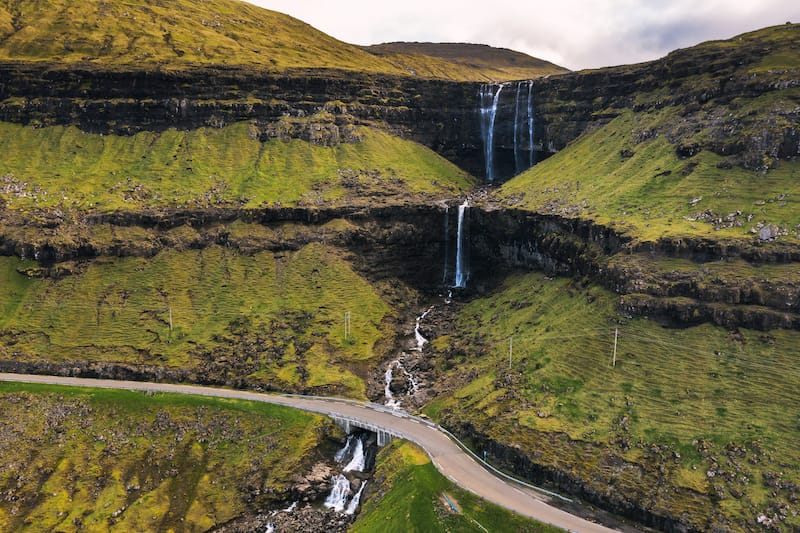
You can watch the waterfall from several viewing points. The lower section is very close to the parking lot, but you can get better views and do some hiking if you climb the rocks.
The trail is not an easy one and requires some physical training. At the top, you will have epic views of the ocean, the waterfall, and the valley full of wildflowers.
The best panoramic view of the waterfall and its surrounding cliffs opens from the island of Eysturoy across the water (1 km away).
11. Mykines
With only 40 houses and 15 villagers, Mykines Island is one of the most beautiful places on Faroe Island. This remote car-free gem, located in the North Atlantic Ocean, is accessible only by air six months of the year.
From April, the village can be reached by ferry, and life in Mykines gets a fresh start.
Mykines is perhaps best known for its abundant birdlife, including the iconic Atlantic puffin. These charming seabirds make their nests on the island’s cliffs and provide an incredible spectacle for visitors.
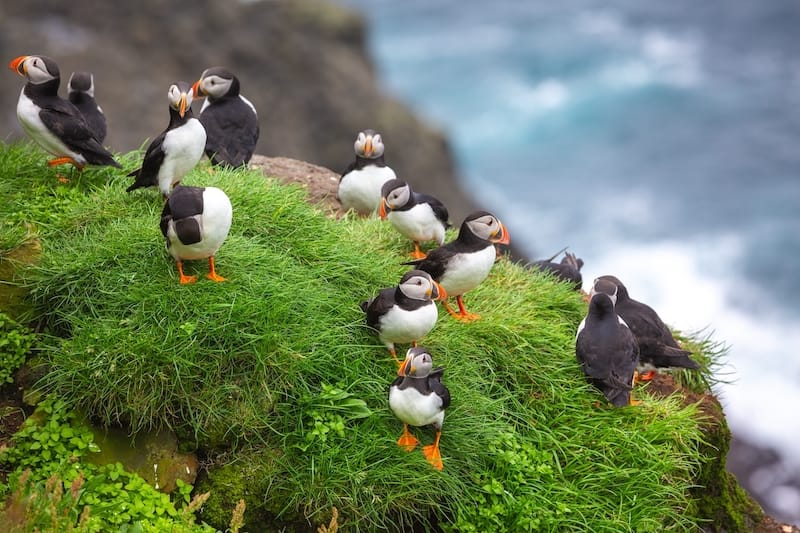
The best time to visit for puffin sightings is from May to August, when they are most active.
While puffins are the main attraction, the island’s standout site is its iconic red and white lighthouse at the western tip of Mykines. Guided tours through the multiple trails alongside dramatic cliffs will help you discover the island’s true beauty.
NOTE: There is a small hiking fee on the island per person.
12. Sørvagsvatn Lake
The Faroe Islands boast unreal scenery that is far beyond any imagination. One such place is Sørvagsvatn, a serene lake perched high above the ocean, seemingly defying gravity.
Also known as Lake Leitisvatn, it is located in the northern part of Vagar Island, on a rocky plateau overlooking the ocean. At the lowest part of the lake, there is the Bøsdalafossur waterfall cascading down into the Atlantic Ocean.
One of the most remarkable aspects of Sorvagsvatn Lake is its optical illusion. As you approach the lake from the cliffs above, it appears as though the lake’s waters are suspended hundreds of feet above the ocean below.
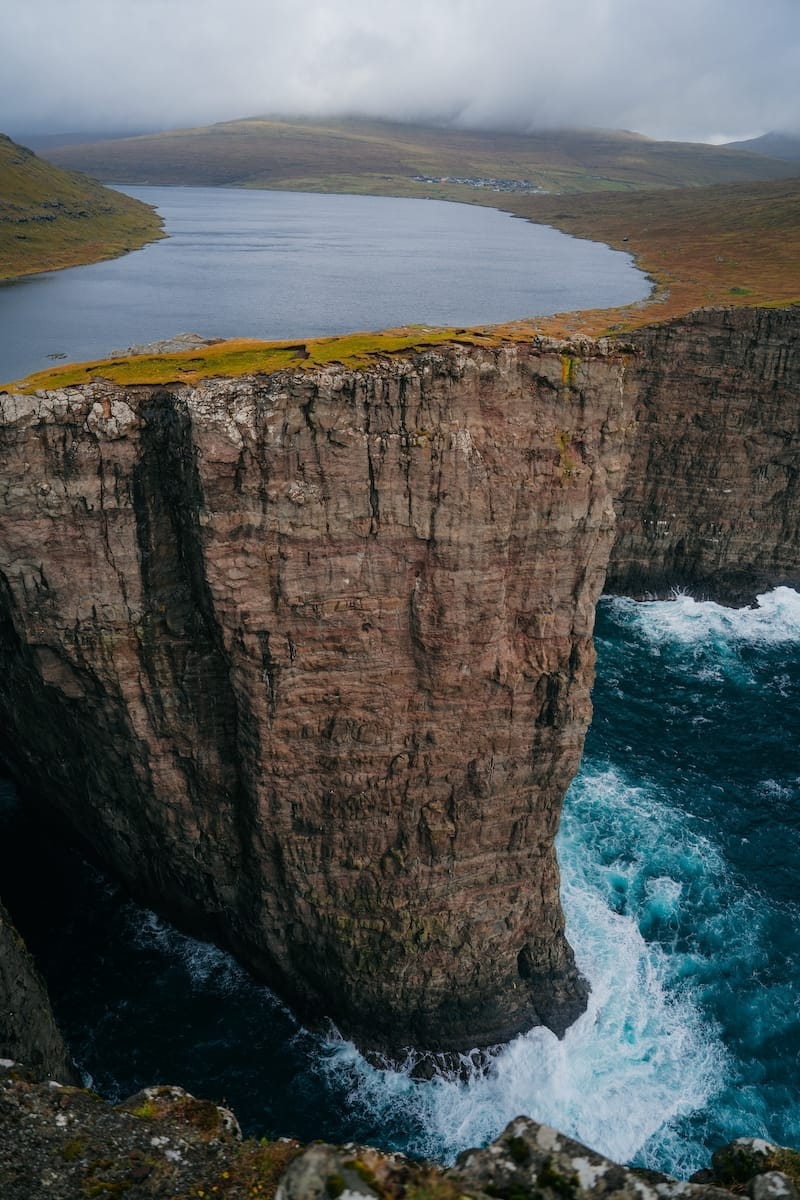
This fascinating illusion is a result of the lake’s location relative to the cliffs and the ocean. Sorvagsvatn Lake sits on a plateau with cliffs, that drop sharply into the Atlantic Ocean below.
When viewed from the right angle, the cliffs obscure the lower portions of the lake, creating the illusion that the lake is floating in mid-air.
To see this beauty from the viewpoint, you can take a moderately challenging hike from Midvágur to Trælanípa.
13. Kunoy
Kunoy Island and its village of Kunoy is a popular tourist destination for its “forest.” One may say there is nothing special about forests, but for the Faroe Islands, it is one of a kind.
The park is a testament to the Faroese commitment to reforestation, and it’s a refreshing change of scenery from the typical rugged cliffs and dramatic fjords that define the Faroe Islands.
There are several groves planted, and you will surely explore all of them, but start with the most beautiful one, the Forest of Kunoy and its fields of flowers and alleys.
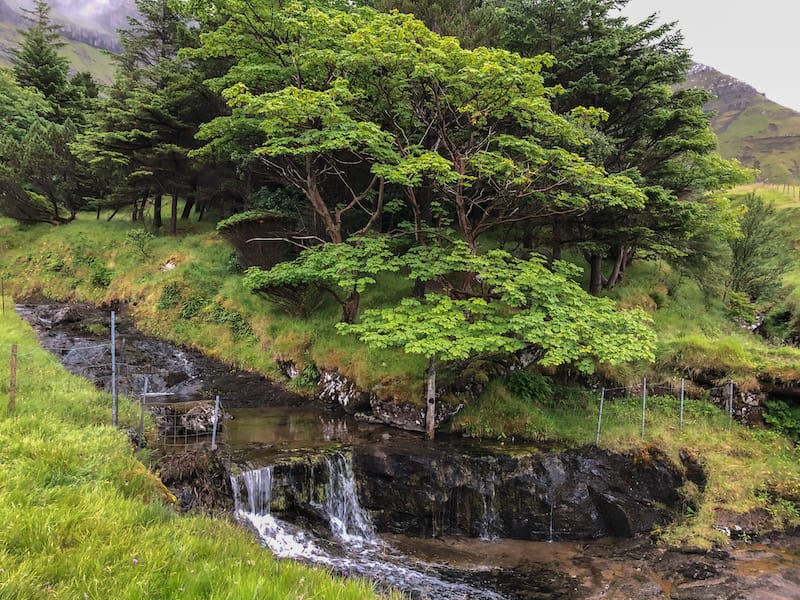
Besides the forest, Kunoy Island boasts numerous hiking trails to the mountains. One of the trails will take you to Kúvingafjall, the highest peak of Kunoy.
Another impressive view is waiting for you on the Skarðsgjógv trail that will take you to the abandoned village of Skarð. Both routes are challenging and require some skills.
Click here to check out a short post documenting my trip to Kunoy!
14. Saksun
Perched atop a beautiful lagoon, Saksun is a small village on Streymoy island that invites with its fantastic views of the mountains and waterfalls.
The best way to explore the territory is to hike the Saksun to Tjornuvík 7-kilometer trail (4.35 miles) through fierce cliffs.
The main attraction of the village is the stunning tidal lagoon, surrounded by dramatic mountains. The serene lagoon, called Pollurin, is framed by black-sand beaches and green meadows that form a natural harbor.
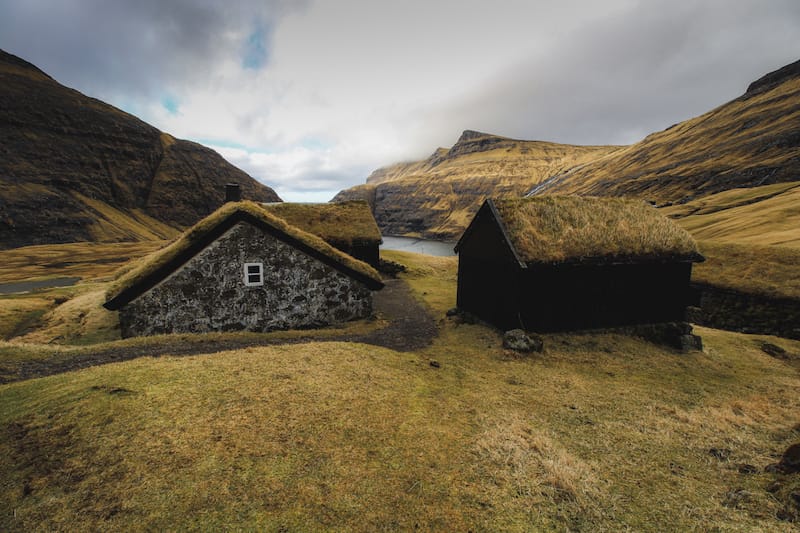
The houses of the village are covered with moss, seamlessly blending into nature, and only the church stands out in the deep green with its white facade and turf roof.
Even though there are only 11 residents in Saksun, the village has a small Dúvugarðar museum open in the summer.
P.S. A great part of Saksun is privately owned and closed to tourists. There are signs to warn you, so be attentive not to get into trouble.
15. Drangarnir
Drangarnir is one of the most recognizable scenes in the Faroe Islands and a natural wonder not to miss. Between Vágar and the islet Tindhólmur, you will see two rock formations in the sea, Stóri Drangur and Lítli Drangur.
These amazing formations are visible from the land of Bøur and Gásadalur, but you can also take a guided tour to Drangarnir and get closer to the sea stacks on the boat.
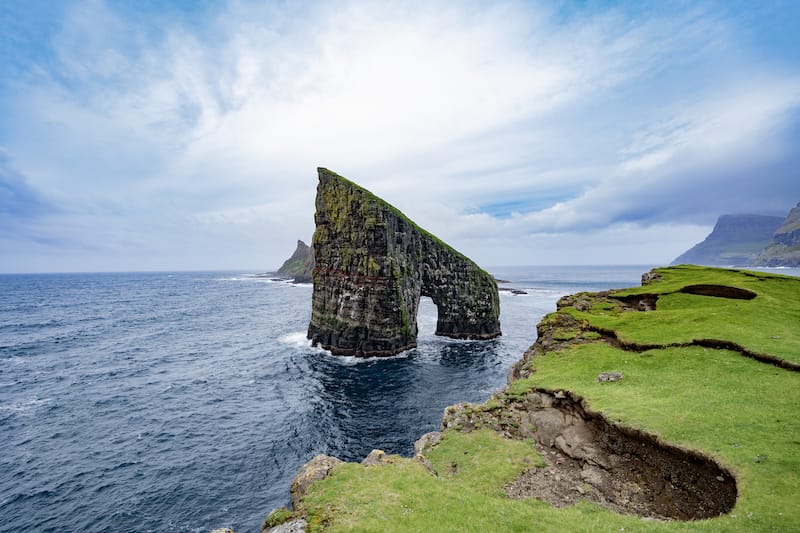
The most exciting moment is sailing through the arch. The only concern is that tours are weather-dependent.
Hiking to the viewpoint of Drangarnir is another fantastic way to experience the island. The trail starts in the village of Sørvágur on Vágar Island.
From there, it’s about a 4-5 hour round-trip hike to reach Drangarnir. The terrain can be challenging, so it’s essential to be adequately prepared.
16. Bøur
Bøur is a small village on the west side of the Faroe Islands and one of the most visited places for its stunning scenery, which includes views of the sea, the islet Tindhólmur, and the sea stacks Drangarnir.
This flawless panorama is completed with the turf houses of the village that don’t bother the natural idyll.
While in the village, visit the Bøur church, a characteristic white church with a serene setting. Also, take a walk around the village, which is full of charm.
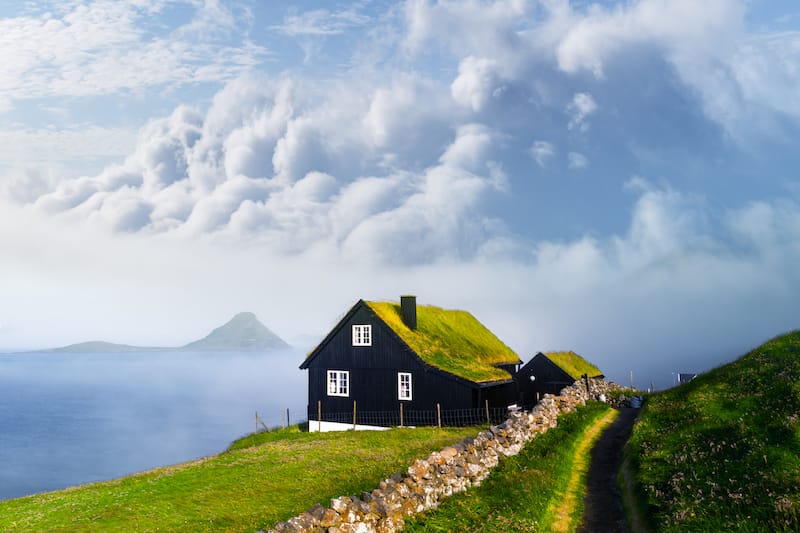
Next, you can hike to Tindhólmur, a small islet located just off the coast of Bøur. It is a popular hiking destination, but it is important to note that the hike can be challenging.
Bøur can also be a starting point for hiking to Gásadalur and its beautiful waterfall, Múlafossur.
17. Bosdalafossur Waterfall
One of the most unique places in the Faroe Islands is Bosdalafossur Waterfall, a majestic waterfall that plunges 30 meters (98 feet) into the ocean below.
It is located on the western coast of the island of Vágar and is fed by the no less unique lake of Sørvágsvatn, a lake with a rare optical illusion.
The scene of the lake and the waterfall is truly dramatic, surrounded by fierce cliffs and often hiding behind thick layers of fog.
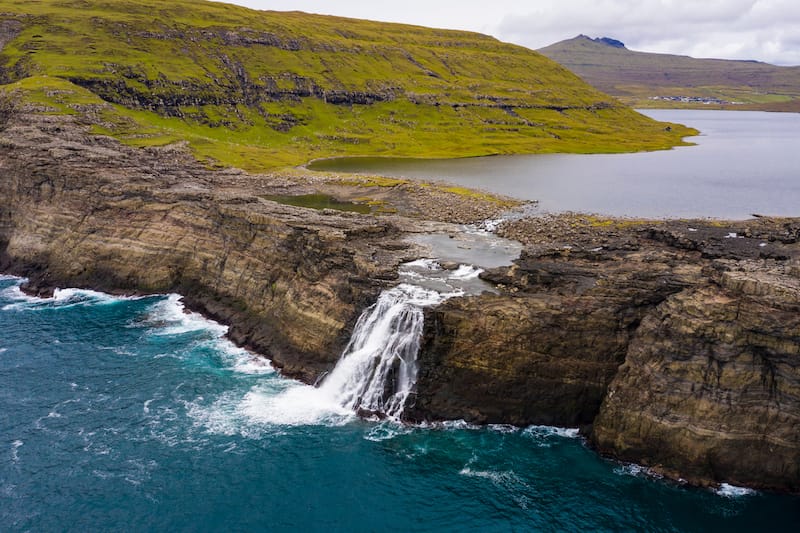
To reach the waterfall, you can take a 3-kilometer (1.86 miles) hike from the village of Miðvágur. The route is relatively easy, but there is a steep section at the end.
Once you reach the waterfall, you’ll be rewarded with breathtaking views. From this point, you will also see the free-standing rock walls of Geituskorardrangur and Trælanípa.
18. Slættaratindur Mountain
Slættaratindur is the highest mountain in the Faroe Islands, towering at 880 meters (2887 feet), located on the island of Eysturoy. The mountain’s name translates to “flat peak,” which is an accurate description of its summit.
Lovers of hiking will find the ascent to the mountain really attractive. The trail starts from the village of Gjógv and takes about 4-5 hours to reach the summit.
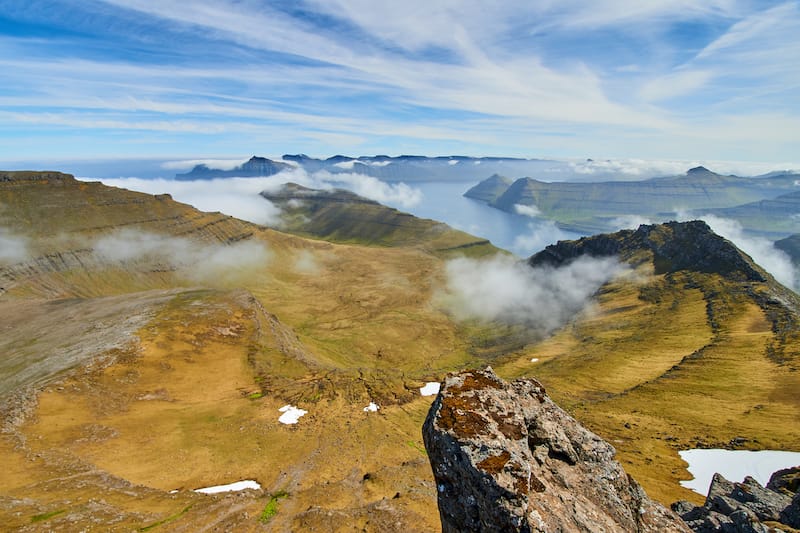
The trail starts from Eiðisskarð mountain pass, taking 2 hours to get to Slættaratindur. The last section is steeper and more challenging. There are a few sections where you will need to scramble over rocks.
Once you reach the summit, you will be rewarded with stunning views of the Faroe Islands. During winter, it is covered with ice and thick fog, and hiking can be dangerous.
In summer, when the weather is clear, you can see Risin and Kellingin sea stacks and the entire archipelago.
19. Hvannhagi
Hvannhagi is a remote valley on the southern island of Suðuroy that is a truly magical place with towering mountains, dramatic cliffs, and a picturesque lake called Hvannavatn.
The lake is the main attraction that can be visited by hiking from the village of Tvøroyri. The marked trailhead starts above the hospital, leading to Hvannhagi and further to the lake.
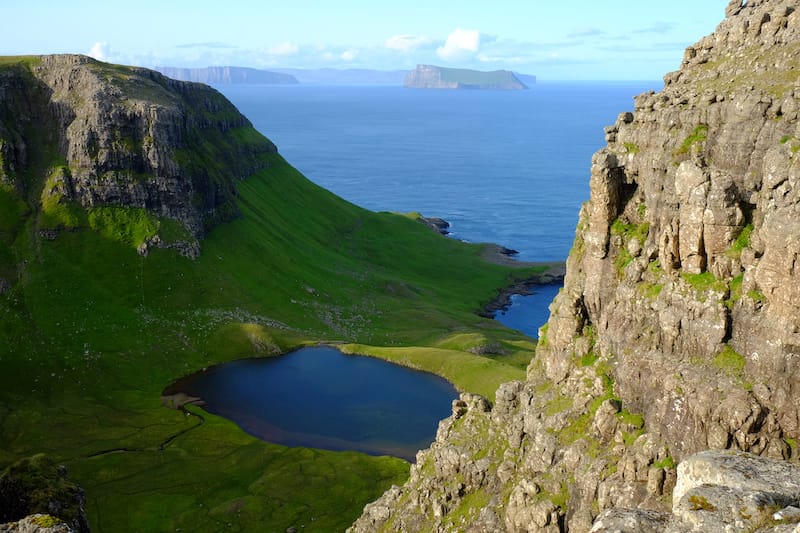
This exciting hike is 7.7 kilometers (4.8 miles) with moderate difficulty, but any effort is worth it to see those views. Hvannhagi is the least visited site in the Faroe Islands, so you will have a chance to enjoy the views all by yourself.
Going higher up the hill, you will enjoy the views of Lítla Dímun, Stóra Dímun, and Sandoy. Closer to the lake, the route will drop down, getting steep and rugged. Sturdy shoes are a must on this route.
Once you reach the lake, you will see a serene scene surrounded by a crescent of mountains.
20. Vestmanna Bird Cliffs
The Vestmanna Bird Cliffs, or Vestmannabjørgini, are one of the most popular and unique tourist attractions in the Faroe Islands, and for good reason.
These towering cliffs are home to seabirds, including puffins, guillemots, razorbills, and fulmars that find safe shelter here for nesting.
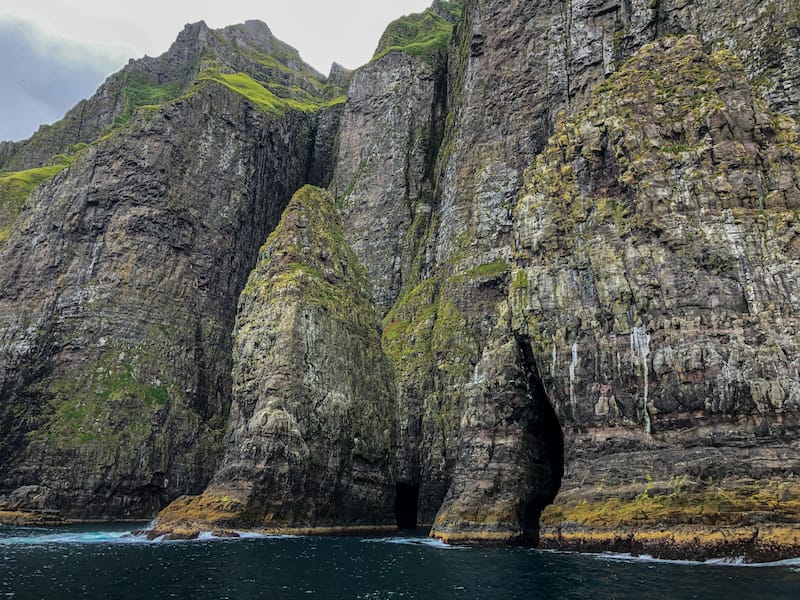
The cliffs are located between Vestmanna and Saksun and can be visited on a boat. The boat tours typically last around two hours and take you close to the cliffs, where you can see the birds up close.
In addition to the birds, you’ll also see some amazing scenery on your boat tour. The cliffs are over 700 meters high (2298 feet) and are dotted with caves and grottoes.
Some boats sail under the arches and cliff tunnels, giving you unparalleled experience.
21. Viðareiði
Viðareiði is a small village on the northernmost tip of the Faroe Islands, on Viðoy Island. It is a remote and beautiful place between two towering mountains overlooking a dramatic coastline.
The island of Viðoy is connected to the main island of Streymoy by a tunnel and a bridge, so it is quite easy to visit Viðareiði from Tórshavn.
Viðareiði is a great base for exploring the northern Faroe Islands.
You can spend some time exploring the town (we can call it town because it is a fairly large village with 350 residents) with its beautiful church and neat houses before moving to the nearby attractions.
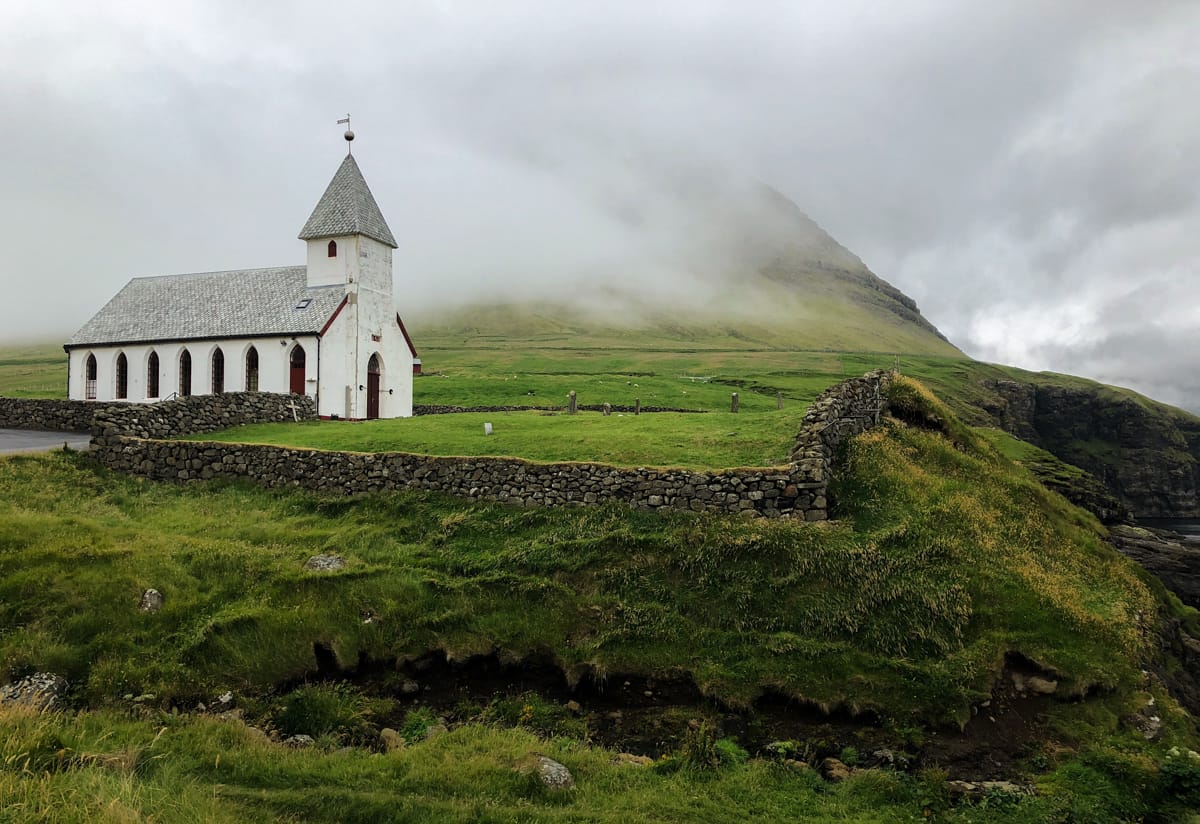
But Viðareiði is most visited as a starting point to the top of Villingadalsfjall. This mountain is the highest peak in the northern Faroe Islands and offers stunning views of the surrounding area.
Get ready for a challenging walk that will end with great views of Viðareiði and Malinsfjall. You can continue the route further to Cape Enniberg, a 754-meter sea cliff (2473 ft) and one of the world’s highest promontories.
22. Hvithamar
Hvithamar is a popular viewpoint on Eysturoy Island that offers stunning views of the Funningsfjørður fjord and the surrounding mountains.
To get to Hvithamar, you will need to drive to the Gjáarskarð mountain pass on the island of Eysturoy. From the mountain pass, there is a short and easy hike to the viewpoint.
The hike takes about 15-20 minutes with no challenging ascents or descents. The trail is marked by short green poles; besides, the path is well-worn and easy to follow.
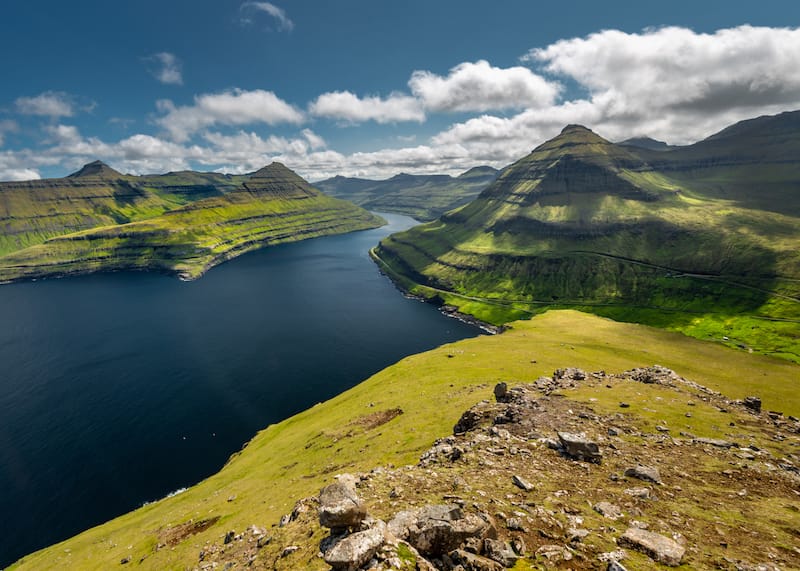
The routes will swing and twist several times before it reaches the viewpoint. On a clear day, you can even see the island of Kalsoy in the distance.
Often Hvithamar’s viewpoint is included in the tour of the village of Gjógv as the best alternative to get the most out of your trip to the Faroe Islands.
Places in the Faroe Islands (On a Map!)
Did I miss any of the best places to visit in the Faroe Islands? Let me know your favorite spots in the Faroe Islands below!
More Faroe Islands Travel Guides
- How to visit Kalsoy
- How to visit Kunoy
- Best Faroe Islands hotels
- Best Faroe Islands tours
- How to visit Sandoy
- How to visit Suduroy
- Gjogv travel guide
- Kirkjubour travel guide
- Tjoruvik travel guide
- Camping in the Faroe Islands
- Faroe Islands packing list
- Things to know before visiting the Faroe Islands
- Airbnbs in the Faroe Islands
- Vagar Airport to Torshavn
- Most photogenic spots in the Faroe Islands
Pin this Guide to Towns and Villages in the Faroe Islands
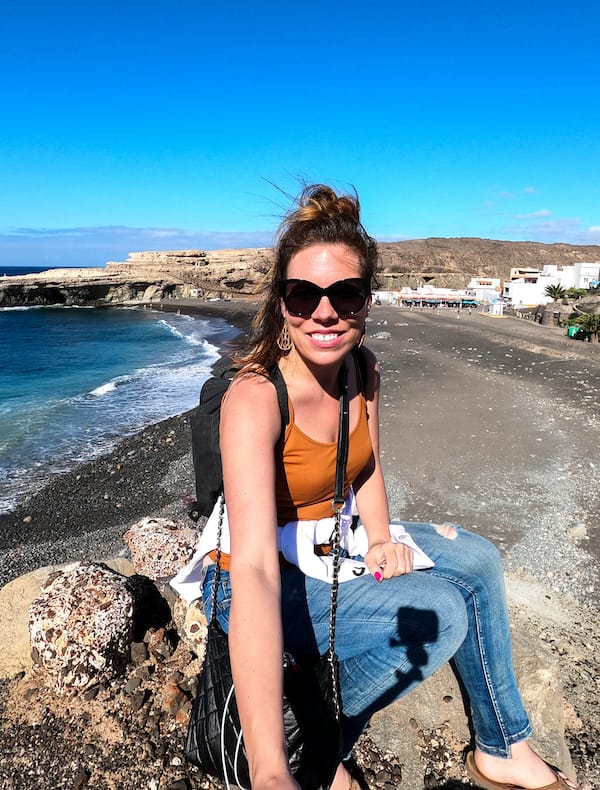
Megan is a travel blogger and writer with a background in digital marketing. Originally from Richmond, VA, she now splits her time between Frankfurt, Germany and Arctic Finland after also living in Norway, Armenia, and Kazakhstan. She has a passion for winter travel, as well as the Nordic countries, but you can also find her eating her way through Italy, perusing perfume stores in Paris, or taking road trips through the USA. Megan has written for or been featured by National Geographic, Forbes, Lonely Planet, the New York Times, and more. She co-authored Fodor’s Travel ‘Essential Norway’ and has visited 45 US states and 100+ countries.

